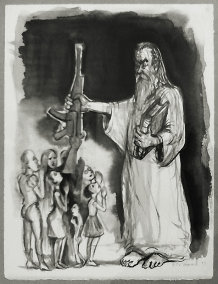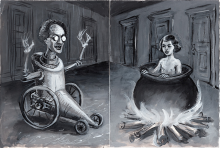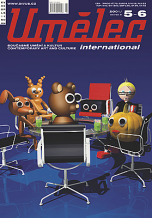| Revista Umělec 2003/2 >> Performance of machines and people in the online environment | Lista de todas las ediciones | ||||||||||||
|
|||||||||||||
Performance of machines and people in the online environmentRevista Umělec 2003/201.02.2003 Denisa Kera | performance | en cs |
|||||||||||||
|
“The internet is actually one big, permanent performance.”
We usually associate performances and happenings with the “real” world, whether it is with the physical body in body-art, with landscape in land-art, or some other type of individual and collective action in public space. These interventions disrupt social practices, rituals or regimes at work, and they often take the form of protest or an attempt at creative and new expression. So performance in the virtual world can sound like a contradiction. However, first a description of the sheer number of different attempts at a similar kind of intervention in the online environment is necessary. Question can be asked, like: In what form are these “virtual” performances and ritual acts being presented on the net? Does the online environment approximate that of the real world? Are the differences between the virtual and real worlds being wiped out? Are they instruments of protest? Are new forms of reality or virtuality being discovered? Performance in the online environment, whether it’s an intervention into a game designed for a large number of users (the so-called massive multiplayer online games MMOGs) or simple www pages, includes not only humans but also machines. Except for attempts to synchronize or improvise acts on the web, like rituals and theater, most online performance leans towards activism. In similar projects there is the tendency to erase differences between online and off-line environments by showing the many examples of physical violence and attacks. However, oftentimes the most distinct performances are those that do not include users, but machines. These are a breed of pure machine performance, without any human factors, whether it’s the web itself or hardware and software. This category includes projects like Every Icon by John Simon or the computer suicide Forkbomb.pl by Alex McLean. Machine performances emphasize the autonomy of the online environmental processes and impersonate various characteristics of the web, software or hardware. In fact, performance is always a discovery of new forms of reality or “parallel” worlds with different rules. In this sense, machine and web performances are a discovery or a view of a “parallel” world without people. Online theater and activist performance Online theater performance and various attempts at performance in 2-D and 3-D in the virtual world leads to interesting confrontations between spontaneous, casual behavior and ritual. Exactly these ritual forms of behavior distinguish the theater or the performance from the virtual community, which arises around spontaneous manifestations like a game or the simultaneous communication of chatting, etc. This confrontation often resembles protest or provocation, like in the performance Quake Friends and other experiments in the online environment by Joseph Delappe (www.delappe.ws). Delappe uses online games like Quake, where players go to shoot, as public space for ritualized behavior, including the recitation of poetry or the reading of dialogues, which muck up the spontaneity of the shooting, injecting confusion into the game. Quake Friends is a peculiar LAN party in which five of Delappe’s friends decide to act out an episode from the popular American sitcom Friends in an online environment, instead of shooting. While other players shoot each other, Delappe and his friends recite half-witted rejoinders from the serial, which contrasts well with the aggressive nature of the game. In another similar performance Delappe joined the shooter Elite Force Voyager (http://www.voyagereliteforce.com) as Allen Ginsberg and recited his anti-war poem “Howl,” which begins with the words “I saw the best minds of my generation destroyed by madness.” In the world of online gaming, using recitation and dialogue are not common or even acceptable ways of behavior: weapons and fast reflexes are the name of the game. The confrontation of popular series and video games creates a number of funny situations, serving as criticism of both environments and their monotone ways of looking at the world. Whether its a kitschy serial in which the speech turns into a round of shrieks and neurotic giggling, or online shooting which reduces all human communication, interaction and movement to killing, both environments are equally rigid. Reciting an anti-war poem in an online shooter does sound cynical. On the one hand, this kind of protest is pointless, as in this case it’s not about real war and is unconvincing. In fact, similar games show how life in times of peace is actually boring and the excitement of death and killing attractive. Different from these types of squats and happenings, a number of other projects attempt to create software to serve the online performance. Projects like http://www.artificialstage.com or http:// www.avatarbodycollision.org/ used 2D graphics to chat: the so-called Palace offers users the visage of an avatar to speak with the help of comic word bubbles. One group of female artists has, for a long time now, explored the possibilities in webcams, graphics and text chat environments for the interconnections of online and off-line performance, resulting in this year’s art software for cyberspace, Upstage. This software connects chatting with videoconferencing with the help of the webcam and creates an environment for virtual theater and performance. What is interesting about these projects is that they engage the role of the passive public. Most online performances are entirely dependent on the user’s activity on the web. This was the case when users collaborated to create a flag for the internet in the project Netflag (http://netflag.guggenheim.org/netflag/) or the group composing music in the project Soundspace (http://www.wayform.net/ soundspace.html) or collages in Codepixels (http://www. codedpixels. org/). Online performances are in fact an improvisation before an audience with the use of different media. At the same time it is necessary to count on their randomness and uncontrollable nature — when the machines fail or behave other than they should, creating from the whole performance something like “crises management.” The goal of the performance is mainly to confront the online and offline environments with the help of theater plays that also resemble computer games, like for example in the project Screen Save Her, or anti-war protest in the project Dress the Nation. This activist performance transformed naturally into a cyber-demonstration when veiled women — avatars in burkas — began to proceed to other chat room palaces and protested their silencing by remaining silent. As for the future, artists are counting on mobile telephones links, allowing the performance to spread out from people sitting at the computer or in a physical theater to people in the streets. The confrontation of the stage, street and chat environment with the help of webcams always has a peculiar alien effect. In this kind of performance it is never longer clear whether what we are participating in and what we see projected on the screen is actually simultaneous. The confrontation of live performance and mediated images on a screen breaks our tie to the present moment and the “immersive” quality of performance. It brings a view which is at the same time direct and mediated, human and “machine,” and it frustrates our presence at the performance, as well as the difference of the online and offline environments itself. Performance 24 hours a day and online rituals In the past, a number of other projects attempted to use chatting and other tools for simultaneous communication in a poetic way. There was, for example, Cosy Corner (http://www.cosycorner.org), which connected many webcams to one screen, or the very interesting Unmovie (http://193.197.170.79/). This flash application programmed in the language of Python allows people to communicate with special robots, which becomes a group effort to write a collective poem. The robots, or programs, work with the texts of well-known writers, singers and famous personalities. They actually allow us to creatively chat with them in their language. We find there, for example, the robot Jimi (Bob Dylan), which talks to us with the lyrics of Dylan songs or Drella, which is Andy Warhol, and with cyber-erotic seisha, a Japanese Geisha. From film there is Tark (Andrej Tarkovskij) and Dogen the Zen master from the 13th century who proffers his wisdom. The words, which appear during our discourse with these bots, automatically run the movies from the database, which creates something like a shared performance of the bots and people. Interestingly, the contact between robots and other users in this environment makes us hear only the words in our proximity, which imitates the intimacy of real discussions or, on the other hand, lack of interest. Ground Zero by John Cabral (http:// www.turbulence.org/Works/groundzero/) uses other characteristics of the online environment than previous experiments with simultaneity, robots or collaboration on the net. Ground Zero is an online performance that runs 24 hours a day and which makes use of the timeless nature of the environment. The internet is actually one big, permanent performance, and the 24-hour animation story of the rat Ratzo runs every day all day, while texts, sounds and events are generated automatically according to the time of the day and other conditions. The story takes place on the net, regardless of whether someone is watching it or not, ignoring the user and time as it mimics the autonomy of the entire environment. The cyber-fable about the rat Ratzo which we can enter to discover for a moment how the “inhabitants” getting on. Another 24-hour Sheherazade was Rosemary Heather’s project http:// www.mobydickonline.org/, a permanent online reading of the famous novel Moby Dick. The book is actually “read” by a program, word by word, so all 233,334 words take 72 hours to read, after which another mechanical reading begins. Moby Dick has been read non-stop since June 2001. We can participate as users in the ritual only by going to the site and getting a random sentence from the novel every day. This mechanical reading performed by a machine alienates us from the intimate experience of reading and understanding books. At the same time the entire project pays homage to the novel. The endless reading creates a virtual world dedicated to a book which is constantly being performed and presented in the online environment. Moby Dick lives on the internet as a being or bot in the form of signals transmitted on the web, which continuously structures the words and sentences from the novel. Another peculiar internet reading is the project In the image of the text by Gregory Chatonsky (http://www.incident.net/works/in_the_image_of_the_text/) in which a book by Alain Robbe-Grillet appears and is read along with images found on Google. The web brouser here becomes a story-teller that continuously makes present and translates text by Robbe-Grillet using images and collage. Unlike these continuously running projects with no user input, the virtual performance Wirefire by Entropy8Zuper! (http://entropy8zuper.org/wirefire/) attempts to emphasize the ritual form of traditional performances. Rather than the timeless character of the virtual environment or the mechanical behavior of its bots, here it focuses on the presence of people at a certain time. This online performance brings together the public and a pair of artists, Auriea Harvey and Michael Samyn, once a week through the web page, where everyone together creates a digital collage. The online performance took place from 8 July 1999 until 9 January 2003 every Thursday at midnight, and they can now be found in an archive. The improvisations included chatting, sounds, images, video, animation, webcams, every type of available technology, which they used during the performance to interact with the artists and the public. The basis of the entire project was the ritual regularity and presence of the artists and audience in the same environment. Deciding who is who on one web page is not always easy and so users are marked with small black dots, particles of dust, and in the whole ritual, common interaction is more important than identity. Very similar to this online ritual is the art project Ethereal Smackdown (http:// www.museotamayo.org/infomera/), which parodies a wrestling arena in which once a week “battles” take place between “www champions” in the form of 48-hour improvisations and fights between two selected artists. Software and hardware performance: computer suicide and attempts at digital immortality The entire online environment is a web of continuous interaction between users and their computers. Most online performances therefore naturally aim to use and emphasize this user activity on the web, whether its in the shape of collaborative drawings, composing music, creating collage or other types of common activity. A smaller number of projects attempt to connect robots and other factors to these interactions or enable the passive role of the audience. Different factors in some performances include the hardware and software themselves, where human interaction, acts or interests are not participating, but rather the bots. The performance of machines or programs alone, like in the famous project Every Icon by John F. Simon (http:// www.numeral.com/appletsoftware/eicon.html), completely ignores both the user activity and the human time itself, as well as our ability to grasp and understand. Unlike the cyclical works with repeating performances on the web (24 or 72 hours) or time-limited performances of similar rituals, Every Icon is a performance with an unusual timeframe that leaps over “human” and possibly even “planetary” time and could run for many millions of years. Every Icon attempts to design a machine or software which could produce every possible image on a given screen. The creation of these images or icons in a grid of 32 x 32 patches representing pixels is a mathematical as well as esthetical performance that studies computer possibilities rather than our imagination or nature. The gradual filling and combining of these patches imitates the work of bitmap graphics with pixels. We perceive the images created on the page as a process rather than as static examples. The creation of all pixel combinations on this grid would take a few hundred trillion years, because an average computer can manage about 100 icons per second. This important work of electronic art from 1997 presents, on the one hand, the possibilities of a software that is able to put into algorithm processes that surpass human and measurable time. On the other hand, it shows the limits of hardware’s ability to execute these algorithms, simply because no computer can run for many millions of years. This conceptual project as a Java application surpasses not only the possibilities of hardware, but also human life and the whole of evolutionary development: It is not possible to follow the performance of all icons. An image of software immortality that ignores human time and even the “physicality” of hardware possibilities presents computer code as an alien entity, not quite belonging to our world. Radically, it confirms the autonomy, if not “immortality” of some programs. At the same time, this performance presents the theoretical and algorithmic form of “machine” immortality, as well as the impossibility to finish a project of this kind. Computers gaining independence from humans is celebrated in another kind of project that prefers to represent computer mortality rather than immortality. The elegant forkbomb.pl by Alex McLean (http://runme.org/project/+forkbomb/) is a simple program in the language Perl. This performance appears to be kind of computer suicide. After some commands are entered, the computer engulfs itself in constantly multiplying processes, automatically generated by the command “fork.” This suicidal attack on the operating system of the computer has different results depending on the parameters, but it always offers a view of a system under an attack. A similar computer suicide lets us understand its “inner” life controlled by codes. The whole experience could be compared to a fictional look at the work of genes creating cancer in the human body. Writing forkbomb even became an artistic genre or a type of performance in itself. The most elegant suicidal code up to now, forkbomb was written by an Italian artist and hacker using the nickname jaromil http://dyne.org/. If you type into the command line of a computer using Unix his row of smilies :(){ : :& };: the system will simply collapse. Very famous, next to software virus destruction or suicidal programs, is the example of hardware destruction, Tsunamii.Net Alpha 3.5 Crush (http:// www.fragnetics.com/projects/crush/). The art group Tsunamii performed on 12 September 2002 a physical destruction of the web server number 195.195.81.5 in a public demonstration in Millbank Gallery in London, and then in front of an online audience with the use of a webcam. The demolition was preceded by a week-long countdown and in total 70,000 people participated in the performance. Virtual performance, whether in the form of online protests, various rituals or hardware and software exhibitions, prove that they can be intimate to people in the “real” world. Thanks to virtual performance we are discovering new dimensions of the net and technologies which work, live and react even without us. Moreover, the autonomy of machines in the form of suicidal and murderous attacks or experiments with longevity codes may be the first view of a world without people, reflecting a certain evolutionary “exhaustion” of our species. In his book Myths of the Future from 1982, J.G. Ballard links the hidden fear of technologies with the violence and dominance of pornography. According to him, the spread of pornography and violence in various media becomes a symptom of our extinction: “A widespread taste for pornography means that nature is alerting us to some threat of extinction.” Whether these performances include fear and unconscious aggression, or a search and celebration of new evolutionary possibilities and life-forms, it is to be hoped that there is still enough time left to decide.
01.02.2003
Artículos recomendados
|
|||||||||||||
|
04.02.2020 10:17
Letošní 50. ročník Art Basel přilákal celkem 93 000 návštěvníků a sběratelů z 80 zemí světa. 290 prémiových galerií představilo umělecká díla od počátku 20. století až po současnost. Hlavní sektor přehlídky, tradičně v prvním patře výstavního prostoru, představil 232 předních galerií z celého světa nabízející umění nejvyšší kvality. Veletrh ukázal vzestupný trend prodeje prostřednictvím galerií jak soukromým sbírkám, tak i institucím. Kromě hlavního veletrhu stály za návštěvu i ty přidružené: Volta, Liste a Photo Basel, k tomu doprovodné programy a výstavy v místních institucích, které kvalitou daleko přesahují hranice města tj. Kunsthalle Basel, Kunstmuseum, Tinguely muzeum nebo Fondation Beyeler.
|









































 New book by I.M.Jirous in English at our online bookshop.
New book by I.M.Jirous in English at our online bookshop.
Comentarios
Actualmente no hay comentariosAgregar nuevo comentario